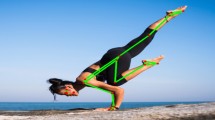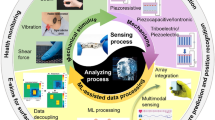Abstract
Exercise therapy is a prominent method for recovering from musculoskeletal disorders like Work-related Musculoskeletal Disorder (WMSD), Classroom-related Musculoskeletal Disorder (CMSD). This method requires the monitoring of a physiotherapist to advise the performer to do the exercise poses correctly. This process is costly and requires the presence of a physiotherapist. In this work, we plan to develop software for the real-time detection of exercise poses with the help of AI. This work replaces the physiotherapist and provides good real-time feedback on the users' wrist extension and flexion exercise posture. Artificial Intelligence (AI) is the most popular and widely used technique for real-time image analysis. In real-time the user takes at least 1 s to perform the exercise pose. Our model classifies and provides feedback within 0.79 s. The frame processing rate of our model is ~ 21 frames per second. Experimentation of this framework was done through CNN DenseNet with 2-level architecture. We have experimented with three different ways of outcomes. Our mode achieved 100% accuracy with 106 samples of data and 99.86% accuracy with 2160 samples. Finally, with 144 cross-person sample datasets achieved 83.33% accuracy. This technique performs well for evaluating wrist extension exercise poses for recovery and gives participants immediate feedback on whether their wrist extension is correct or incorrect.














Similar content being viewed by others
Data availability
Data is not available openly to protect study participant privacy.
References
Wang, H., Sun, M.: Smart-VPoseNet: 3D human poses estimation models and methods based on multi-view discriminant network. Knowl.-Based Syst. 239, 107992 (2022). https://doi.org/10.1016/j.knosys.2021.107992
Anand Thoutam, V., Srivastava, A., Badal, T., Kumar Mishra, V., Sinha, G.R., Sakalle, A., Bhardwaj, H., Raj, M.: Yoga Pose Estimation and Feedback Generation Using Deep Learning. Comput. Intell. Neurosci. 2022, 1–12 (2022). https://doi.org/10.1155/2022/4311350
Rangari, T., Kumar, S., Roy, P.P., Dogra, D.P., Kim, B.-G.: Video-based exercise recognition and correct pose detection. Multim. Tools. Applicat. (2022). https://doi.org/10.1007/s11042-022-12299-z
Bijalwan, V., Semwal, V.B., Singh, G., Mandal, T.K.: HDL-PSR: Modelling Spatio-Temporal Features Using Hybrid Deep Learning Approach for Post-Stroke Rehabilitation. Neural. Process. Lett. (2022). https://doi.org/10.1007/s11063-022-10744-6
Cai, H.: Application of intelligent real-time image processing in fitness motion detection under the internet of things. J. Supercomput. 78(6), 7788–7804 (2022). https://doi.org/10.1007/s11227-021-04145-0
Zheng, H., Zhang, H., Zhang, H.: Design of Teaching System of Physical Yoga Course in Colleges and Universities Based on Computer Network. Sec. Commun. Networks 2022, 1–9 (2022). https://doi.org/10.1155/2022/6591194
Sharma, A., Shah, Y., Agrawal, Y. and Jain, P. (2022). Real-time Recognition of Yoga Poses using computer Vision for Smart Health Care. arXiv:2201.07594 [cs]. [online] Available at: https://arxiv.org/abs/2201.07594.
Qiu, Y., Wang, J., Jin, Z., Chen, H., Zhang, M., Guo, L.: Pose-guided matching is based on deep learning for assessing the quality of action in rehabilitation training. Biomed. Signal Process. Control (2022). https://doi.org/10.1016/j.bspc.2021.103323
Moran, A., Gebka, B., Goldshteyn, J., Beyer, A., Johnson, N. and Neuwirth, A. (2022). Muscle Vision: Real-Time Keypoint Based Pose Classification of Physical Exercises. arXiv:2203.12111 [cs]. [online] Available at: https://arxiv.org/abs/2203.12111
Hassan, H.A. (2020). Automatic Feedback For Physiotherapy Exercises Based On PoseNet. [online] www.semanticscholar.org. Available at: https://www.semanticscholar.org/paper/Automatic-Feedback-For-Physiotherapy-Exercises-On-Hassan/ea513c84c02709a96ef33ccf602dacc14846488a
Varghese, A., Panicker, V.V.: Impact of musculoskeletal disorders on various agricultural operations: a systematic review. Sādhanā (2022). https://doi.org/10.1007/s12046-022-01809-2
Chan, V.C.H., Ross, G.B., Clouthier, A.L., Fischer, S.L., Graham, R.B.: The role of machine learning in the primary prevention of work-related musculoskeletal disorders: A scoping review. Appl. Ergon. (2022). https://doi.org/10.1016/j.apergo.2021.103574
Taifa, I.W.R.: A student-centered design approach for reducing musculoskeletal disorders in India through Six Sigma methodology with ergonomics concatenation. Saf. Sci. 147, 105579 (2022). https://doi.org/10.1016/j.ssci.2021.105579
Rodrigues, P.B., Xiao, Y., Fukumura, Y.E., Awada, M., Aryal, A., Becerik-Gerber, B., Lucas, G., Roll, S.C.: Ergonomic assessment of office worker postures using 3D automated joint angle assessment. Adv. Eng. Inform. (2022). https://doi.org/10.1016/j.aei.2022.101596
Vinothini, P., Halim, I., Radin Umar, R.Z., Too, Y.W., Halim, I.: A FUTURE FRAMEWORK FOR MUSCULOSKELETAL DISORDERS SYMPTOMS AMONG COMPUTER OFFICE WORKERS. Int. J. Physioth. 5, 6 (2018)
Li, Y., Wang, C., Cao, Y., Liu, B., Tan, J., Luo, Y.: Human pose estimation is based in-home lower body rehabilitation system. IEEE Xplore (2020). https://doi.org/10.1109/IJCNN48605.2020.9207296
Vijayakumar, P., Sridhar, A., Baalaaji, A., Sangeetha, M.: A palm vein recognition system based on a support vector machine.". IEIE Transact. Smart. Process. Comput. 8(1), 1–7 (2019)
Ponnusamy, V., Marur, D.R., Dhanaskodi, D., Palaniappan, T.: Deep Learning-Based X-Ray Baggage Hazardous Object Detection-An FPGA Implementation. Rev. d’Intelligence Artif. 35(5), 431–435 (2021)
Chen, T., Or, C.K.: Development and pilot test of a machine learning-based knee exercise system with video demonstration, real-time feedback, and exercise performance score. Proceed. Human. Fact. Ergonom. Soc. Ann. Meet. 65(1), 1519–1523 (2021). https://doi.org/10.1177/1071181321651109
Correia, F.D., Molinos, M., Luís, S., Carvalho, D., Carvalho, C., Costa, P., Seabra, R., Francisco, G., Bento, V., Lains, J.: Digitally assisted versus conventional home-based rehabilitation after Arthroscopic Rotator Cuff Repair. Am. J. Phys. Med. Rehabilit. (2021). https://doi.org/10.1097/phm.0000000000001780
Jo, B., Kim, S.: Comparative Analysis of OpenPose, PoseNet, and MoveNet Models for Pose Estimation in Mobile Devices. Traitement du Signal 39(1), 119–124 (2022). https://doi.org/10.18280/ts.390111
Ponnusamy, Vijayakumar, Amrith Coumaran, Akhash Subramanian Shunmugam, Kritin Rajaram, and Sanoj Senthilvelavan. "Smart glass: real-time leaf disease detection using YOLO transfer learning." In 2020 International Conference on Communication and Signal Processing (ICCSP), pp. 1150–1154. IEEE, 2020.
Author information
Authors and Affiliations
Contributions
Conceptualization-D.E. and V.P; Methodology- D.E. and V.P, Software- D.E., Validation- D.E. and V.P, Formal analysis- D.E. and V.P, Investigation- D.E. and V.P; Data curation- D.E. and V.P, Writing—original draft- D.E Writing—review and editing--D.E. and V.P; Visualization--D.E. and V.P; Supervision-V.P; Project administration-V.P
Corresponding author
Ethics declarations
Conflict of interests
The authors declare no competing interests.
Additional information
Publisher's Note
Springer Nature remains neutral with regard to jurisdictional claims in published maps and institutional affiliations.
Rights and permissions
Springer Nature or its licensor (e.g. a society or other partner) holds exclusive rights to this article under a publishing agreement with the author(s) or other rightsholder(s); author self-archiving of the accepted manuscript version of this article is solely governed by the terms of such publishing agreement and applicable law.
About this article
Cite this article
Ekambaram, D., Ponnusamy, V. Real-time AI-assisted visual exercise pose correctness during rehabilitation training for musculoskeletal disorder. J Real-Time Image Proc 21, 2 (2024). https://doi.org/10.1007/s11554-023-01385-6
Received:
Accepted:
Published:
DOI: https://doi.org/10.1007/s11554-023-01385-6




